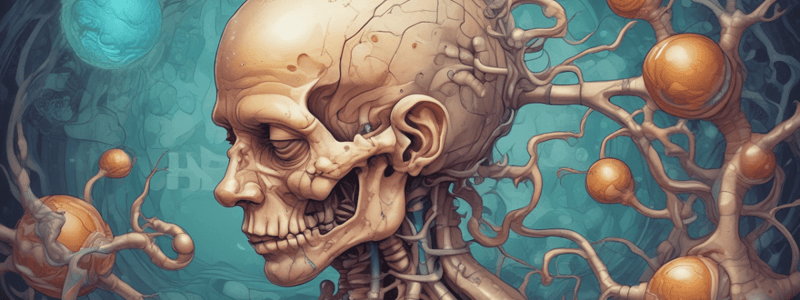Podcast
Questions and Answers
What percentage of CSF is produced by the choroid plexus?
What percentage of CSF is produced by the choroid plexus?
- 50-80% (correct)
- 20-30%
- 10-20%
- 30-50%
What is the primary site of CSF absorption?
What is the primary site of CSF absorption?
- Cerebral cortex
- Ventricles
- Sagittal sinus (correct)
- Brain stem
What is a symptom of hydrocephalus in infants?
What is a symptom of hydrocephalus in infants?
- Small head size
- Increased appetite
- Rapid weight loss
- Vomiting (correct)
What is a long-term effect of hydrocephalus on cognitive function?
What is a long-term effect of hydrocephalus on cognitive function?
What is a sign of hydrocephalus in infants?
What is a sign of hydrocephalus in infants?
What does the term 'hydrocephalus' literally mean?
What does the term 'hydrocephalus' literally mean?
What is the result of a blockage in the circulation of CSF from spaces within the brain?
What is the result of a blockage in the circulation of CSF from spaces within the brain?
What is a common physical problem associated with spina bifida?
What is a common physical problem associated with spina bifida?
What is a common challenge for individuals with spina bifida and hydrocephalus?
What is a common challenge for individuals with spina bifida and hydrocephalus?
According to Rosseau et al (1992), what is the critical cerebral mantle thickness below which treatment may not be effective?
According to Rosseau et al (1992), what is the critical cerebral mantle thickness below which treatment may not be effective?
Which of the following is an example of primary brain malformation leading to hydrocephalus?
Which of the following is an example of primary brain malformation leading to hydrocephalus?
What is a possible effect of hydrocephalus on the eyes?
What is a possible effect of hydrocephalus on the eyes?
What is the term for the condition where the lower part of the brain goes further down the spinal cord than usual?
What is the term for the condition where the lower part of the brain goes further down the spinal cord than usual?
Which type of hydrocephalus occurs when there is a blockage in the flow of CSF?
Which type of hydrocephalus occurs when there is a blockage in the flow of CSF?
What is the primary function of CSF?
What is the primary function of CSF?
What can be a cause of communicating hydrocephalus?
What can be a cause of communicating hydrocephalus?
What is a common symptom of short term memory impairment?
What is a common symptom of short term memory impairment?
What is a characteristic of diminished motivation/initiation?
What is a characteristic of diminished motivation/initiation?
What is a possible consequence of a blocked shunt?
What is a possible consequence of a blocked shunt?
What is a characteristic of executive functions impairment?
What is a characteristic of executive functions impairment?
What is a possible symptom of altered concept of time?
What is a possible symptom of altered concept of time?
What is a possible treatment for the condition mentioned in the content?
What is a possible treatment for the condition mentioned in the content?
Flashcards are hidden until you start studying
Study Notes
Definition of Hydrocephalus
- Hydrocephalus occurs when there is a blockage in the circulation of CSF from spaces within the brain (ventricles) out over the surface of the brain and down the spinal cord.
- When too much CSF gets trapped in the pathway, the ventricles expand and put pressure on the brain.
Aetiology-Based Classification
- Primary (Brain Malformation): Dysgenetic (Focal - Aqueductal Stenosis, Global - Holoprosencephaly)
- Secondary: Trauma, Aneurysmal Subarachnoid Haemorrhage, Infection, Tumour
Classification
- Communicating Hydrocephalus: occurs when more CSF is produced than can be reabsorbed (e.g. meningitis, traumatic brain injury)
- Non-Communicating Hydrocephalus: blockage in the flow of CSF (e.g. spina bifida, tumours, meningitis)
CSF
- CSF is a clear, colourless fluid that provides nutrients to the brain and spinal cord and takes away waste products.
- It acts as a shock absorber between the skull and the brain, and between the spinal cord and the spine.
CSF Production and Absorption
- 50-80% of CSF is produced by the Choroid Plexus through an energy-dependent process.
- 20-50% is a by-product of CNS metabolism.
- Primary site of absorption is the Sagittal Sinus, through a passive process.
Symptoms
- High-pitched cry, poor feeding, vomiting, large head, full and hard fontanelles.
- Headache, lethargy, and sunset eyes (where the white of the eye can be seen at the top of the eye).
Signs
- Large head size or rapidly growing head.
- Full fontanelles ('soft spot') in a baby.
- 'Sunset eyes' and frontal bossing (the forehead more prominent).
Long-term Effects
- Children with spina bifida may have physical problems, learning difficulties, and difficulty concentrating.
- Some may have vision problems, epilepsy, headaches, and early onset of puberty.
- Fine motor skills may be impaired, affecting drawing and sports.
- Short-term memory impairment, short attention span, and diminished motivation/initiation.
Management
- Drainage, surgery, and medication.
- Third ventriculostomy and shunt management (with potential complications of blocked shunt).
Studying That Suits You
Use AI to generate personalized quizzes and flashcards to suit your learning preferences.




